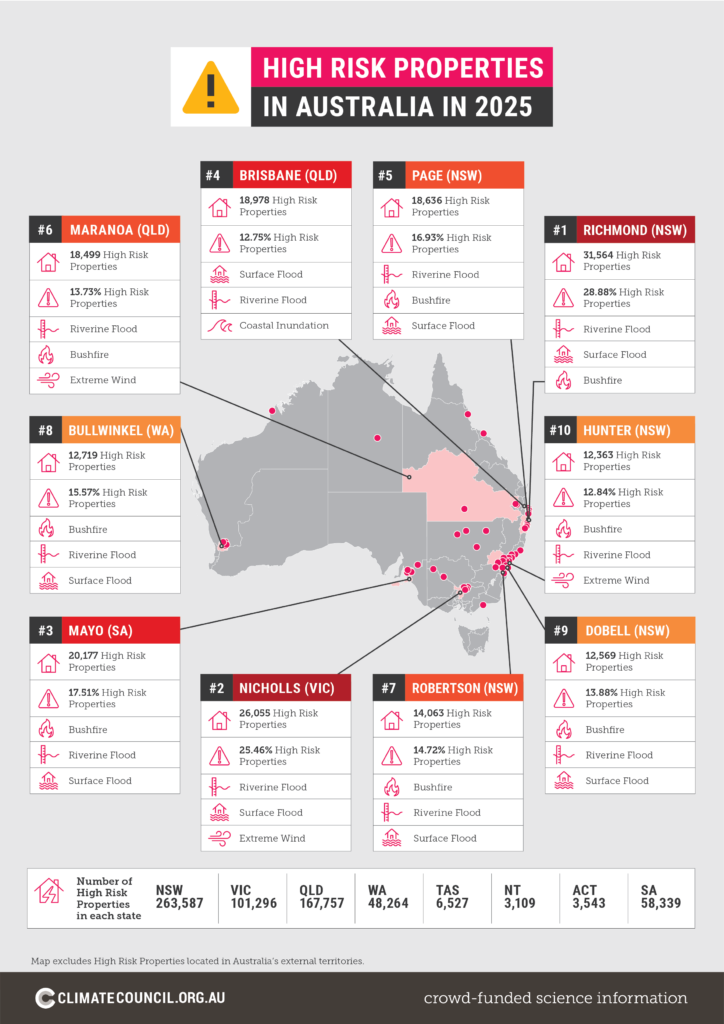NEW DATA OUT TODAY exposes the electorates where homes and businesses are most at risk from climate-fuelled flooding, bushfires, tropical cyclone winds, coastal inundation, and extreme wind.
The Climate Risk Map, an interactive online map using fresh data from Climate Valuation, allows every Australian to see the climate risks in their local area.
A new report, At Our Front Door, analyses this data at a national level. It finds:
- One in 23 Australian homes and businesses, or 652,424 properties (4.4%), across the country are already at high risk today from one or more hazards that have been made more dangerous by climate pollution.
- Another 1.55 million properties (10.4%) nationally are at moderate risk – for which insurance costs will be abnormally high. That's a further one in 10 properties.
- At high levels of climate pollution, our exposure to climate risk is set to get much worse, with twice as many properties (more than 1.3 million) at high risk by 2100.
- Further, the analysis finds that more than 72,000 homes and businesses are located in 86 suburbs categorised as "critical climate risk zones", where 80-100% of properties are classified as high risk and insurance may soon become unaffordable or withdrawn entirely.
Climate Councillor and economist Nicki Hutley said: "The climate crisis is literally at the doorstep of Australian households, as worsening extreme weather driven by climate pollution risks their greatest asset: the home.
"We keep getting hit by disasters in Australia and that's driving insurance bills through the roof, but we cannot insure our way out of this crisis.
"It's not just Australian voters in risky areas who should be looking closely at this. Five of the top 10 ASX-listed companies are banks with significant exposure to climate disaster risk through residential mortgages and loans for commercial property and businesses.
"This election there is a stark contrast between the two major parties' climate policies. The Coalition plans will release billions of tonnes of more climate pollution which will contribute to worsening extreme weather, while the ALP has concrete policies to reduce pollution."
"The Climate Council and Climate Valuation are releasing this data free to the public as we believe people have a right to know the threats they're facing now and into the future."
Climate Valuation founder Karl Mallon said: "Our data draws on 15 million commercial and residential properties in over 15,000 Australian suburbs and 150 electorates. The numbers show us that climate change is not a far-off future event: it threatens entire communities today.
"Most alarmingly, our analysis has identified 86 critical climate risk zones requiring urgent and major government interventions, such as flood levies, buy backs or other measures. It is imperative that decision makers at all levels look seriously at the stark statistics presented here and work to address questions head-on: What adaptation action are all levels of government going to take now to protect our vulnerable communities? And, how will this be financed?"
Climate Councillor and Former NSW Fire & Rescue Chief Greg Mullins said: "As the climate risk map and report makes distressingly clear, no home or business is now safe from the devastating consequences of burning fossil fuels.
"Even if your electorate is in a low risk zone, it does not mean fires or floods won't happen in your local area because climate change has rewritten the rules.
"As the recent fires in LA and Japan show, massive fires can now happen in winter. They can happen in rainforests like the Daintree or in the suburbs of London. We've been through Black Summer, Black Saturday, and the 2003 fires that badly impacted Canberra. Unfortunately, we've already locked in conditions for similar fires again, but we have a choice for the future. We must drive down global climate pollution faster and continue the shift to clean energy. The cost of failing to do so is spelled out in this climate risk map."

To see the risk in your community, visit the Risk Map here






